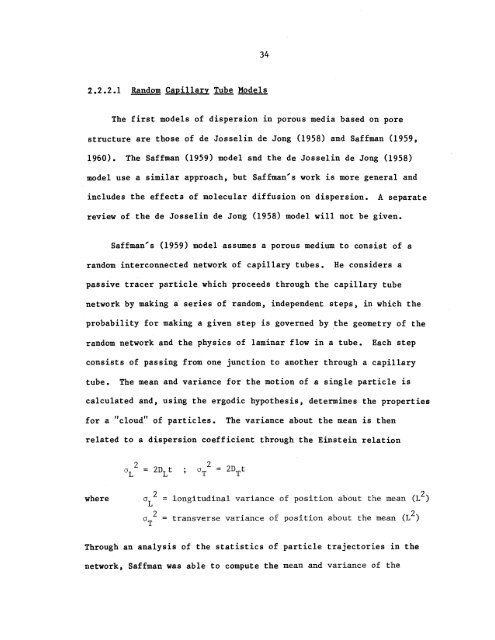longitudinal dispersion in nonuniform isotropic porous media
longitudinal dispersion in nonuniform isotropic porous media
longitudinal dispersion in nonuniform isotropic porous media
Create successful ePaper yourself
Turn your PDF publications into a flip-book with our unique Google optimized e-Paper software.
2.2.2.1 Random Capillary Tube Models<br />
The first models of <strong>dispersion</strong> <strong>in</strong> <strong>porous</strong> <strong>media</strong> based on pore<br />
structure are those of de Jossel<strong>in</strong> de Jong (1958) and Saffman (1959,<br />
1960). The Saffman (1959) model and the de Jossel<strong>in</strong> de Jong (1958)<br />
model use a similar approach, but Saffman's work is more general and<br />
<strong>in</strong>cludes the effects of molecular diffusion on <strong>dispersion</strong>. A separate<br />
review of the de Jossel<strong>in</strong> de Jong (1958) model will not be given.<br />
34<br />
Saffman's (1959) model assumes a <strong>porous</strong> medium to consist of a<br />
random <strong>in</strong>terconnected network of capillary tubes. He considers a<br />
passive tracer particle which proceeds through the capillary tube<br />
network by mak<strong>in</strong>g a series of random, <strong>in</strong>dependent steps, <strong>in</strong> which the<br />
probability for mak<strong>in</strong>g a given step is governed by the geometry of the<br />
random network and the physics of lam<strong>in</strong>ar flow <strong>in</strong> a tube. Each step<br />
consists of pass<strong>in</strong>g from one junction to another through a capillary<br />
tube. The mean and variance for the motion of a s<strong>in</strong>gle particle is<br />
calculated and, us<strong>in</strong>g the ergodic hypothesis, determ<strong>in</strong>es the properties<br />
for a "cloud." of particles. The variance about the mean is then<br />
related to a <strong>dispersion</strong> coefficient through the E<strong>in</strong>ste<strong>in</strong> relation<br />
where <strong>longitud<strong>in</strong>al</strong> variance of position about the mean (L2)<br />
transverse variance of position about the mean (L2)<br />
Through an analysis of the statistics of particle trajectories <strong>in</strong> the<br />
network, Saffman was able to compute the mean and variance of the

















